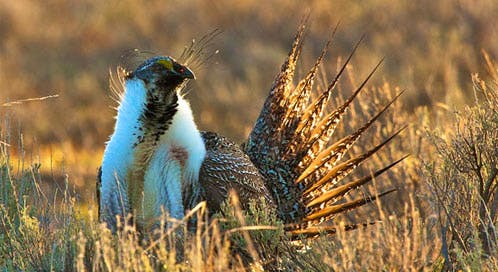Mark Salvo, Federal Lands Policy Analyst
When they’re not engaged in their flamboyant spring mating displays, greater sage-grouse spend the rest of year making a living on vast sagebrush grasslands in the West called the “Sagebrush Sea.” In fact, sage-grouse cannot survive without sagebrush, and they need lots of it. This makes sage-grouse an ideal “umbrella” species for sagebrush habitats.

Sagebrush: More than two dozen varieties of sagebrush occur in the American West, growing in delicate balance with other shrubs, trees, bunchgrasses and wildflowers and providing habitat for sage-grouse and hundreds of other fish and wildlife species. (©Scott Smith)
Umbrella species typically require large expanses of healthy habitat to survive. Because of that requirement, protecting these species also benefits other fish, wildlife and plants within these large areas. Animals of any size can be an umbrella species. Large carnivores, like grizzly bears, are umbrella species for the forests where they roam, and little insects, like the bay checkerspot butterfly, serve the same role for rare native grasslands where they occur.
Though their numbers are diminishing, sage-grouse still live on about 100 million acres in the West. Individual groups of grouse are known to migrate up to 100 miles every year as they move between seasonal habitats. These expansive areas include sagebrush habitat, but also lakes, rivers, streams, springs and wetlands, hot springs, aspen groves, alkali flats, salt flats, sand dunes and rocky bluffs.
Managed properly, this diverse mosaic of habitats supports hundreds of species of fish and wildlife, including the powerful northern harrier, the tiny pygmy rabbit, the fleet-footed pronghorn and the gorgeous Lahontan cutthroat trout. The sagebrush ecosystem is a migratory corridor for birds and important winter habitat for mule deer and elk. At least 15 species of raptors use sagebrush grasslands, and a full complement of carnivores inhabit the landscape, from weasels to mountain lions.
[portfolio_slideshow id=23693]
Unfortunately, as sage-grouse have declined in the West, so have a multitude of other species. More than 350 plant, fish and wildlife species in the Sagebrush Sea are of conservation concern. Of these, approximately 60 species are listed or are candidates for listing under the Endangered Species Act.
Making matters worse, threats posed by improper land use, weed incursion, wildfire and climate change are increasing on the landscape. Continued habitat loss and degradation is threatening a suite of sagebrush birds, including the sage sparrow, Brewer’s sparrow and sage thrasher. Excessive pumping and water diversions are drying up streams and springs, imperiling native fish. Livestock grazing and fire have severely reduced habitat for the pygmy rabbit, and oil and gas drilling has eliminated winter range for mule deer.
Sage-grouse to the rescue!
Federal and state agencies are currently engaged in an unprecedented planning process to conserve sage-grouse across the West. The new plans will affect more than 60 million acres of public lands. If these agencies adhere to the science and abide by their own planning directives, the conservation measures they develop and implement for sage-grouse will have enormous benefits for other species. New land use restrictions, wildlife reserves and restoration programs would ensure that sage-grouse, and a multitude of other fish and wildlife species, survive and flourish on the landscape. Defenders of Wildlife is heavily involved in the planning process and invite you to join us in this important endeavor!
Umbrella species serve as ambassadors for the ecosystems where they live and, while many ecosystems have an umbrella species, few are as charismatic as sage-grouse. The Sagebrush Sea and all of the fish and wildlife that live there are fortunate to be represented by this charming bird.



